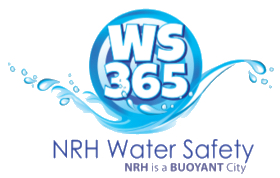Drowning prevention begins with 5 simple steps that are as easy as ABC ... and D and E!
The ABC's of Drowning Prevention: The Details
Active Adult Supervision. Kids should never be alone around water.
You've taught your kids to never go near the water without a grownup. Distractions can wait...a child who has slipped under the water can't. Practice PREVENTION THROUGH ATTENTION each and every time kids are in or around water. Nothing is more important or more effective in drowning prevention than active adult supervision. Walk the perimeter of the pool and scan across the entire length of the water the whole time your kids are swimming. Texts, doorbells and other distractions can wait until everybody is safely out of the water.
Barriers to Prevent Access. Gates and fences prevent access to water.
To be effective, perimeter fences (fencing that goes around your home or yard) must be non-climbable, four-sided and a minimum of 60 inches high. Interior fences (fencing that goes around the pool) must separate the pool or spa from the residence, with openings no more than 4 inches wide, so children can't squeeze through the spaces. Interior fencing must be non-climbable and a minimum of 48 inches high, although 60 inches is recommended. Use self-closing, self-latching fence gates. Mount latches above the reach of small children and ensure gates open away from the pool. Keep gates closed and never prop them open.
CPR and Swim Lessons. Even good swimmers can benefit from swim lessons.
Even very young children can learn how to float and paddle to safety. Everyone in the family should be able to swim. Each year, enroll children in age-appropriate swim lessons taught by a qualified instructor. Never consider kids or teens "drown-proof" or "water-safe" despite their age, swimming skills, previous lessons or water experience. Don't swim alone, regardless of your swimming ability. Anyone of any age can drown at any time.
Parents, grandparents and caregivers should know CPR rescue techniques and to call 9-1-1. Keep your CPR skills current. CPR (Cardio Pulmonary Resuscitation) prevents brain damage by maintaining a person's breathing and heartbeat until medical assistance arrives.
Devices. Use life vests and keep pool noodles nearby.
Life jackets, pool sensors, rescue tools and safety drain covers are vital defenses against drowning. Never go in the water to rescue a drowning person. A swim noodle or towel can be used as a rescue device, but a ring buoy works best.
- At poolside, mount a ring buoy, pool noodles, shepherd's hook and CPR instructions. Make sure rescue equipment is accessible and in good working condition.
- Install and use a toy box that is located away from the pool. Toys in and around the pool entice children to the area. Don't use a floating chlorine dispenser that looks like a toy.
- Insist that all non- swimmers wear a life vest in or near a pool.
- Only use US Coast Guard approved life vests. Floaties, flotation devices and inflatable toys are not designed to be used as life jackets nor substitute for active adult supervision.
Every Day. Practice Prevention through Attention 365 days a year.
North Richland Hills is a Buoyant City. That means we are committed to helping you and your family stay safe in the water. Whether you are in the pool, spa, bathtub, ocean, lake or pond, knowing water safety can save the life of someone in your family. Teach kids to never go near the water without a grownup. Latch those gates. Wear that life vest. Watch those kids. Every. Single. Day. That's Water Safety 365.





